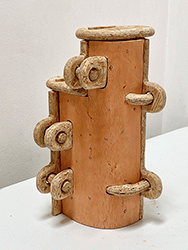June 4 - July 16, 2022
Reception: Saturday June 4, 2022 5-7 pm
Artist Talk: June 25, 11 am
SYDNEY CROSKERY
Starting this process at zero, Croskery begins a painting by building layers of spontaneous fast actions followed by slower detailed punctuations; rinse and repeat (rinse and repeat again).
The action of painting serves as a divining rod for ideas, helping the artist whittle down thoughts about our complicated world until a specific theme aligns itself to the visuals of a piece. These themes become texts, ranging from societal to personal and from serious to absurd, accompanying the exhibition in book form. The consistent through-line of the essays highlights dual perspectives and contradictions, offering an interwoven thought-spectrum of topic and response.
Similarly, the paintings themselves contain this opposition, balancing broad stroke action painting with painstaking details, spontaneity with calculation, translucence with opacity, and the will of the materials with the hand of the artist. As an artist with a background in realism, even her arrival at abstraction is a contradiction.
In Very Important Very Unimportant, Croskery delves into abstraction to make sense of the political, emotional, overwhelming and hilarious aspects of life, with a desire to make rigorous paintings that are simultaneously timely and timeless.
MAX HERTZ
My interest in making– the process of building, assembly, and material– is rooted in a shared memory of learning and playing. The act of play informs our early understandings and interactions with space, object, and body. Toys and educational objects elicit physical and visual interaction, as well as create a sense of permanence. While I am fascinated by the way we learn as children, I am also engaged with the fact that the process changes at some point. In the interest of pushing back on this eventual shift, my work taps into the visual language and functions of play objects like: blocks, jungle gyms, and puzzles. My practice and the development of a language of forms looks to mimic and return to the state of learning, as well as prolong the collective memory of play.
In the series of Capped Vessels, which served largely as a material study in clay, I flipped the order of my usual process of designing, then fabricating. In these new works the clay portions came first, with little vision for the final outcome. The wood elements are informed by the shape and placement of voids in the fired clay and were fit to cap off the forms and create an enclosed body. This shifted order of operations allowed for more real time freedom and play, while also posing a more rigid pre-established puzzle to solve.

